Publication
auri Research Brief
Improving Basement Parking Lot Entrances for Better Pedestrian Safety
- No.89
- 2024.07.22
- Hit 12
- Cho, Youngjin Senior Research Fellow
- Ahn, Euisoon Associate Research Fellow
- Kim, Hyojeong Assistant Research Fellow
Although pedestrian safety should be a top priority when designing basement parking lot entrances, many pedestrians are concerned about such spaces due to frequent pedestrian accidents. Blind spots and inadequate warning systems have been pointed out as major causes of accidents at basement parking lot entrances. This study developed strategies to reduce blind spots in the front view of drivers by installing transition sections and presents detailed standards for the volumes and locations of warning systems. The research findings here were reflected in the “Enforcement Rule of the Parking Lot Act” that was amended in December of 2023. While institutional improvements are crucial for preventing pedestrian accidents in parking lots, improving the safety awareness of everyone who creates, manages, and uses parking lots is also necessary.
Necessity to Ensure Pedestrian Safety in Entrances to Basement Parking Lots
Most basement parking lots in buildings in Korea are designed to have direct access to the driveway through ramps. This type of basement parking lot entrance creates a major safety hazard for pedestrians because the driver's field of vision is limited as the car exits the parking lot and drives up the ramp to the ground level. For pedestrians walking on the sidewalk, the entrances to basement parking lots adjacent to the streets become dreaded spaces where one can never know when a car will suddenly pop up.
In everyday life, basement parking lot entrances, where pedestrians and vehicles encounter each other, are spaces where pedestrian safety should be prioritized. Accordingly, the national government and local governments should amend relevant standards to become more focused on pedestrian safety so that parking lots can become safer. This study aims to propose improvement strategies focusing on ramps and warning systems, both of which directly impact pedestrian safety.
Improving Parking Lot Structures and Equipment Standards for Pedestrian Safety
This study proposed standards for parking lot ramps and warning systems to guarantee pedestrian safety at entrances to basement parking lots. The standards for parking lot structures and equipment to ensure the safety of these parking lots are stipulated in the “Enforcement Rule of the Parking Lot Act.” The standards for installing parking lot ramps and warning systems in the previous “Enforcement Rule of the Parking Lot Act” were mainly aimed at allowing vehicles to move safely in parking lots, with less consideration for pedestrian safety. In response, this study proposes standards for parking lot ramps and warning systems for pedestrian safety.
With regard to parking lot ramps, this study proposes the introduction of transition sections by considering international standards and domestic conditions. The existing standards for parking lot ramps do not include any regulations pertaining to changes that can be made to the longitudinal slopes of the ramps (Article 6, Paragraph 1, Subparagraph Item (d) of the “Enforcement Rule of the Parking Lot Act”). However, the “Regulation on Road Structure and Equipment Standards” stipulates the longitudinal curves that should be installed in parts with changes in the longitudinal slope and regulates changes in the degree (Article 27 of the Regulation on Road Structure and Equipment Standards). This stipulation is motivated by the fact that sudden changes to the longitudinal slope can jeopardize road traffic. Accordingly, this study examined international standards related to transition sections along slopes to propose standards for these slopes that ensure pedestrian safety and to establish appropriate standards by simulating the limited vision of drivers and possible vehicle damage while accounting for the domestic situation.
Regarding warning systems in parking lots, this study proposes detailed standards aimed at pedestrian safety. Field research was conducted to identify the current status regarding the installation and operation of warning systems, and detailed standards to secure pedestrian safety were envisioned based on the findings.
International Standards for Transition Sections
There are international cases where longitudinal slopes are limited and standards are set for transition sections to ensure pedestrian safety and prevent vehicle damage. Examples of such cases are described below.
According to the parking lot design standards set by the City of Los Angeles Department of Building and Safety (LADBS), ramps with a longitudinal slope of 12.5% or greater should have transition sections that reduce the slope by about half, with a minimum length of 2.4m.
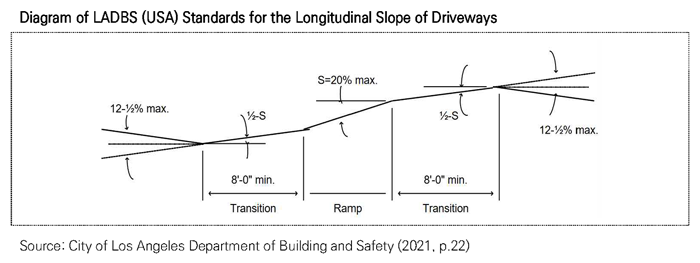
German guidelines on parking facilities stipulate that ramps with a longitudinal slope of 8% or greater should have transitional sections that reduce the slope by approximately half. The length of the transition section, in this case, differs depending on the type of slope. Crests should measure from 1.20m to 2.55m, and sags should be at least 2.00m to 4.25m in length.

The Australian/New Zealand standards require ramps with longitudinal slopes of 12.5% (crest) or 15% (sag) or greater to have transition sections installed, which should be at least 2m long.
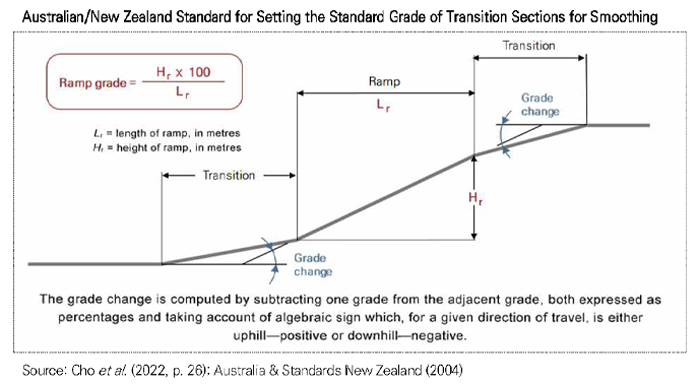
The overall international standards for installing transition sections are similar. The standards for longitudinal slopes that do not require transition sections are lower than those in Korea, and the standards that mandate transition sections are similar. If a ramp with a longitudinal slope of 17% is installed without a transition section, following the Korean standards, the change in the longitudinal slope at the start and end of the ramp will exceed the ranges defined by international standards. This would pose a severe threat to pedestrian safety and to vehicle undercarriages due to possible collisions. Therefore, it is necessary to introduce transition sections in ramp standards in Korea to ensure the safety of both pedestrians and vehicles.
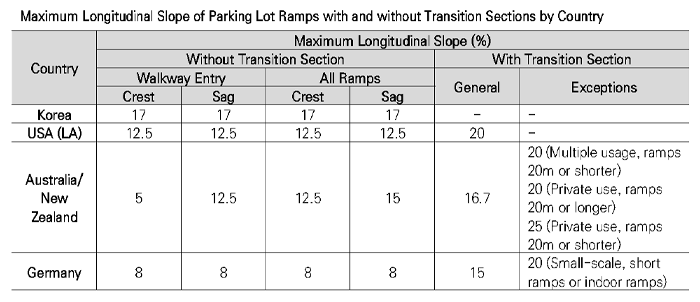
Simulations of Blind Spots and Vehicle Damage on Ramps
This study examined the installation standards for transition sections through simulations to address the problem of blind spots experienced by drivers and the undercarriage of cars touching the ground. First, regarding pedestrian safety, the driver’s forward blind spot at the end of the ramp at the entrance to the basement parking lot was analyzed. This study referred to the results of an experiment conducted by the Korea Transportation Safety Authority (2021, 2022). This experiment found that on a flat road, a driver of a sedan type of car would be able to see a one-meter-tall child standing on the road ahead and that there would be no blind spot. However, this result is limited to flat roads and cannot be applied to ramps. The study also set the height of the child pedestrian as one meter and experimented under identical conditions to simulate blind spots on ramps. Through this experiment, this study accurately evaluated the forward blind spot that can appear on ramps and established a standard for installing transition sections for pedestrian safety.
A vehicle currently in the market with the most disadvantages was chosen for the analysis. Considering that many types of vehicles use basement parking lots, off-road parking lots and annexed parking lots with ramps, it is essential to use a vehicle with appropriate specifications for the analysis so as to develop standards for transition sections by longitudinal slope that account for such diversity. For this purpose, this study reviewed various specifications, including the wheelbase, the level of the driver’s observation point, and the front and back overhang distances, and selected the G model from H company as the subject of the analysis, as it had the most unfavorable specifications.

By applying such experimental conditions, this study simulated the forward blind spots from the vehicle selected for the analysis at the end of the ascending ramp under various longitudinal slopes. First, there were no forward blind spots when the car was on a flat road, just as in the experiment conducted by the Korea Transportation Safety Authority. However, on a ramp with a 17% slope, the maximum longitudinal slope set by the current parking lot structure and equipment standards, a one-meter-tall child pedestrian could not be seen from any location from the car at the end of the ramp. This indicates that a driver would be unable to spot a child pedestrian at the point where the car enters the road and that pedestrian safety cannot be ensured without a transition section.
When the longitudinal slope was set to 8.5%, there was a one-meter blind spot in the front such that the driver was able to spot a child pedestrian who was taller than one meter in front of the car. To achieve this effect, a transition section of at least 3.2 meters, which is the wheelbase of the vehicle, was used in the analysis. Therefore, to prevent a forward blind spot at the entrance of a basement parking lot, a transition section with a longitudinal slope of 8.5% or less and at least 3.2 meters in length should be installed at the crest ramp where the slope changes.

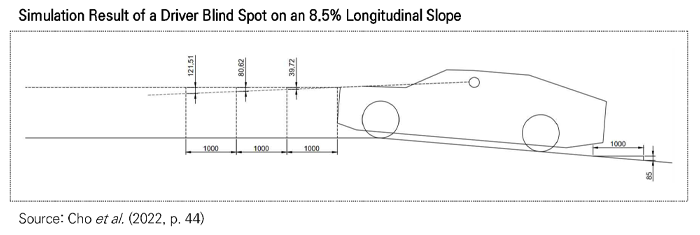
Next, this study analyzed the standards for transition sections to prevent damage to the undercarriages of vehicles. For the start and end of crest ramps, a simulation on a 17% longitudinal slope showed that the undercarriage of the vehicle touches the ground, thus confirming the need for transition sections. There was no contact at the start or end of sag ramps, but previous research (Kim et al., 2014) confirmed that the undercarriages of vehicles could touch the ground depending on their movements, even at the start and end of sag ramps.

The standards for transition sections to prevent vehicle damage were devised by referring to international standards and previous studies conducted in Korea and by simulating parking lot designs with transition sections on ramps so that cars can remain undamaged and not incur additional costs.
First, for the start and end of crest ramps, this study recommended installing a transition section at least 1.7 meters long with a longitudinal slope of 8.5% for parking lots with 50 or more parking spaces. If the ramp necessitates the installation of a transition section for pedestrian safety, an additional transition section would not be required. For conclave ramps, this study proposes the installation of a transition section of at least two meters in length with a longitudinal slope of 8.5% for parking lots with 100 or more parking spaces in consideration of the high design costs compared to the limited expected effects.
The following table outlines the standards for installing transition sections on parking lot ramps to ensure pedestrian safety and to prevent damage to vehicles.

Current Status of the Installation and Operation of Warning Systems
This study also examines how parking lot warning systems are installed and operated to outline measures to improve the standards of parking lot warning systems. Although the “Enforcement Rule of the Parking Lot Act” mandates the installation of warning systems, they have not been properly installed or managed due to a lack of specific standards. This study conducted field research to verify how warning systems are installed and managed.
First, some of the researchers visited parking lots to activate the warning systems while consistently measuring the volume of the alarms to test them. The alarms were tested at a height of 1.2 to 1.5 meters, three meters apart in the direction of the exit.
A survey of 33 buildings in four representative blocks in Sejong City showed that 38.7% of parking lot warning systems were not functioning properly. The loudness of the warning sounds varied from 53 dB to 81.6 dB, while the background noise averaged 66.1 dB.
Next, this study analyzed the visibility of the warning systems. In 45.2% of parking lots with warning systems, the warning systems were difficult to spot due to their surroundings. The cases in which pedestrians on both sides could notice the warning systems amounted to 61.3%, while the systems were difficult to spot in 12.9% of the parking lots. This indicates that even if the warning system is installed in a highly visible location, it is difficult for pedestrians to spot it if the surrounding environment is improperly maintained.
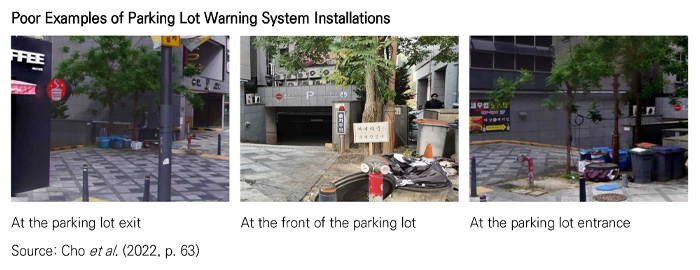
To improve the safety of pedestrians, including those who are visually impaired, at parking lot entrances, standards pertaining to the loudness of the warning systems should be established to ensure that the warning systems cannot be randomly deactivated. In addition, the warning systems should be installed with lighting in highly visible locations to ensure the safety of pedestrians, including those with hearing loss, as noted above. Based on the findings from the field research, this study proposes detailed standards that require warning systems to be located within three meters of the parking lot exit, to be easily visible to pedestrians, and to generate an alarm sound of 50 dB or more.
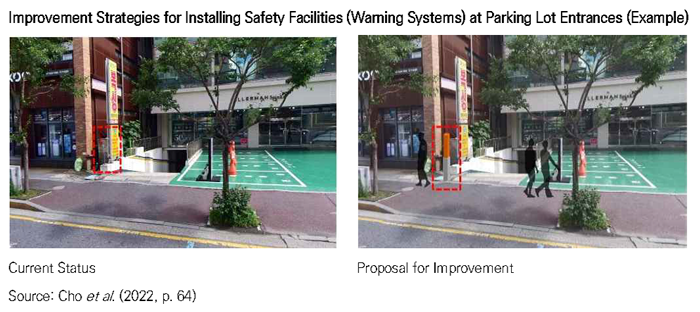
Amending and Implementing the “Enforcement Rule of the Parking Lot Act” to Reflect Improvement Strategies
Based on the suggestions for improving the standards for parking lot ramps and warning systems, this study proposes amendments to the parking lot structure and to equipment standards stipulated in the “Enforcement Rule of the Parking Lot Act.” With regard to ramps, this study proposes that all parking lots install transition sections of at least 3.2 meters to ensure there are no blind spots at the ends of uphill ramps adjoining road and pavement sections. In addition, installing transition sections to prevent vehicle damage would be mandatory depending on the size of the parking lot, especially for parking lots that exceed a certain size and for which transition sections can be installed at no additional cost. For warning systems, this study accounts for the safety of pedestrians and people with disabilities as well as the safety of entering cars and road safety when stipulating the purpose of installing such systems. It also provides detailed standards requiring warning systems to be installed in locations easily recognizable by pedestrians and to generate warning lights and sounds.
The proposals regarding the parking ramps and warning systems were reflected in the newly amended “Enforcement Rule of the Parking Lot Act” in December of 2023. The newly added standards for warning systems went into effect in early 2024, and the standards for transition sections for ramps will take effect starting December 2, 2024. The amended regulation applies to new parking lots constructed after the regulation goes into effect and does not apply to existing buildings.
It is impossible to impose a new policy on the owners and managers of existing buildings by law. Nevertheless, for the safety of existing buildings, accidents can be minimized by installing transition sections on ramps and warning systems in buildings where they can be installed and by ensuring that traffic mirrors and signposts are installed in buildings where transition sections or warning systems cannot be installed. Both government and public attention are needed to transition into a society with safer parking lots for both pedestrians and drivers.
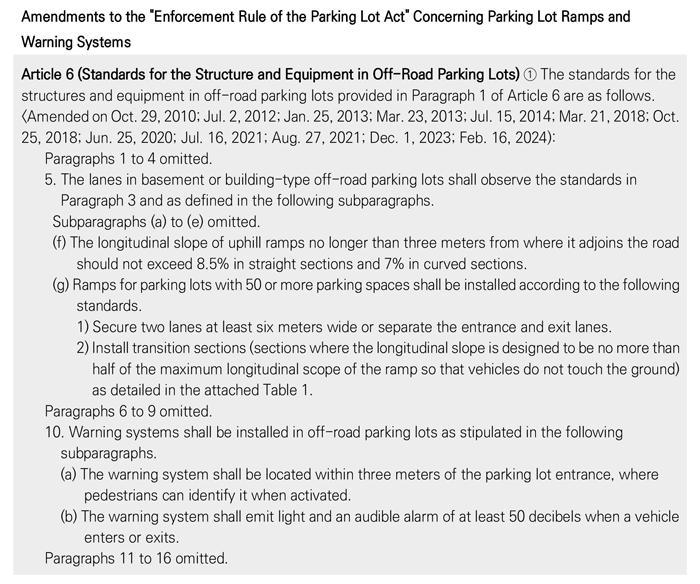

- Cho, J. (2017). Power Outage… Darkened Basement Parking Lots. Yonhap News. February 2.
- Cho, Y., Ahn, E., Kim, H. & Ryu, S. (2022). A Study on Parking Lot Structure and Equipment Standards and System Improvement. Ministry of Land, Infrastructure and Transport.
- City of Los Angeles Department of Building and Safety. (2021). Parking design, Los Angeles Municipal Code 12.21A5.
- “Enforcement Rule of the Parking Lot Act.” Ordinance of the Ministry of Land, Infrastructure and Transport No. 1279. Amended on Dec. 1, 2023.
- FGSV. (2014). Empfehlungen für Anlagen des Ruhenden Verkehrs. Translated by Lee, Seonha. Cheong Moon Gak Publishers.
- Kim, Y., Kwon, S., Park, J., Kim, B. & Ha, T. (2014). A Study on Determination Elements of Vertical Curve at Parking Lamp. Conference Paper, Journal of Korean Society of Transportation, 70, 246-250.
- Korea Transportation Safety Authority. (2021). “Hidden in Plain Sight,” Blind Spots in Cars… Understanding is Key to Preventing Accidents. Press Release. 9 December.
- Korea Transportation Safety Authority. (2022). Results of Blind Spots in Cars. Internal Document from the Korea Transportation Safety Authority.
- Standards Australia & Standards New Zealand. (2004). Parking facilities, Part 1: Off-street car parking (AS/NZS2890.1:2004).
